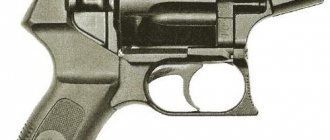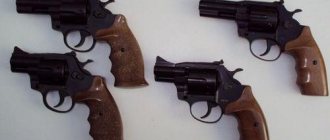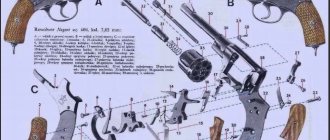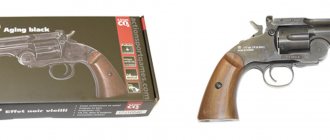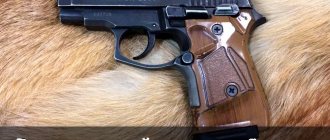This term has other meanings, see TKB.
This term has other meanings, see Cobalt (meanings).
| OTs-01 "Cobalt" | |
| Type | revolver |
| A country | Russia |
| Production history | |
| Constructor | Igor Yakovlevich Stechkin, Boris Vasilievich Avraamov |
| Designed by | 1991—1992[1] |
| Manufacturer | Instrument Design Bureau |
| Years of production | since 1992 |
| Characteristics | |
| Weight, kg | 0.820 (without ammo) |
| Length, mm | 200[1] |
| Barrel length, mm | 75[1] |
| Cartridge | 9×18 mm |
| Caliber, mm | 9 |
| Work principles | double acting |
| Initial bullet speed, m/s | ~310 |
| Sighting range, m | 25 |
| Type of ammunition | 6-round drum |
Revolver RSA
- Russian revolver, developed in 1991-1992. designers TsKIB SOO I. Ya. Stechkin and B. V. Avraamov[1].
The revolver was developed by order of the Ministry of Internal Affairs of the RSFSR drawn up in 1991 [2] and in 1992 adopted by the Ministry of Internal Affairs of the Russian Federation under the name RSA
(«
Revolver Stechkin - Avraamova
»)[1].
First 200 pcs. revolvers under the symbol OTs-01 "Cobalt" were produced at TsKIB SOO [3], then production was moved to the Zlatoust Machine-Building Plant (city of Zlatoust) and (city of Uralsk).
What is a traumatic weapon
Good afternoon, dear gun lovers. Today I am starting a column dedicated to weapons, namely traumatic ones. But first, I think it’s worth understanding what a traumatic weapon is, and how does it differ from other means of self-defense?
Traumatic weapons, “traumas”, “traumatic weapons”, in most countries all these names are classified as non-lethal weapons.
Categories of traumatic (non-lethal) weapons
It is divided into several categories:
- Barrelless firearms (civilian)
- this includes weapons such as WASP, GUARD, AEGIS, etc. - Gas revolvers and pistols capable of firing rubber bullets
are IZH-79-9T MAKARYCH, ICEBERG GR-2071, MR-341 HAUDA, TKB-0216T AGENT and others - Firearms of limited destruction
- this category appeared after 2011 and included some representatives of the previous category - IZH-79-9T MAKARYCH, as well as pistols such as GRAZA and its modifications, MP 353, Lom 13 and others. - Service weapon of limited destruction with traumatic cartridges
- Jorge, RS, MP 471 and others
Attitude to traumatic weapons in the Russian Federation
In our country there is a very ambiguous attitude towards traumatic weapons. This is due to the increasing number of crimes involving the use of gas, barrelless and firearms of limited destruction. For the most part, “traumatic weapons” are purchased by our citizens for the purpose of self-defense.
Wearing trauma gear
You can carry it in a car, wear it every day (only in a holster), you can read about how to get it in my article on the procedure for purchasing a traumatic weapon.
Use of traumatic
You should also remember and know that possessing a “traumatic injury” entails a very great responsibility!
It can be used only in extreme cases, when there is a clear threat to your life, otherwise, instead of a defending victim, you can easily end up in the dock. To avoid this, carefully read the rules for using traumatic weapons!
So, having figured out what a traumatic weapon is, answer yourself the following questions: what do you want from owning a “traumatic weapon”, do you really need it, and most importantly, are you ready to take on such a great responsibility to society?
Well, after that you can go to the store for permission! See you soon!
Characteristics
The Nagan traumatic revolver has the following characteristics:
- The weight of the weapon is 700 g.
- The pistol is designed to fire 4.5 mm bullets.
- Combat force – 3 J.
- The fired bullet is capable of developing a maximum initial speed of up to 120 m/s. However, judging by numerous reviews from owners, after 60 shots the initial speed drops to 90 m/s.
- CO2 gas is used as a filler for the cylinder.
- The revolver is used for shooting at a distance of up to 230 meters.
As evidenced by reviews from the owners of these traumatic Nagans, one can is enough to fire 100-105 shots. In this parameter, other air pistols are inferior to Glatcher. In addition, to release the self-cocking mechanism in the traumatic Nagan, unlike its combat counterpart, less effort is required - only 3 kg, which increases shooting accuracy and comfort in operation.
Literature and sources
- Revolver OTs-01 "Cobalt", RF patent for invention No. 2007685, M. class. F 41 C 3/10, 3/14, prior. 06.12.91;
- 9-mm revolver OTs-01 (TKB-0216). Passport OTs-01 PS
- 9mm RSA revolver. Technical description and operating instructions TKB-0216TO - 1992
- Yuri Kotelnikov. Special forces weapons: Cobalt revolver // Bratishka magazine, June 1999
- Sergey Monetchikov. Arsenal: Revolvers. Weapons of Russian law enforcement agencies of the 21st century // “Brother” magazine, March 2008
USM device
Nagan revolvers are equipped with hammer-operated, double-action trigger mechanisms. The pistols contain firing pins that are hinged on the triggers. The handle became a place for the location of a plate-shaped two-feather mainspring. There are no safeties for revolvers. During the first tests of the weapon, designers noticed leaks of powder gases at the breech end and the front end of the drum. This drawback was corrected by using a trigger mechanism that pushed the drum forward each time before firing. Thus, when cocking the hammer, the drum is shifted forward by activating a specific locking mechanism. Then, due to the trigger, the drum is locked and its rotation is stopped.
Design
The revolver frame is cast from aluminum alloy, and the barrel, drum and internal mechanisms are made of steel. A special clip is used to load and remove cartridges from the drum. When extracting cartridges, the drum is tilted to the side, and then all cartridges are simultaneously pushed back by an extractor hidden inside the drum axis.
Sights are non-adjustable, front sight and open rear sight with luminous marks to facilitate aiming in low light. Double action trigger mechanism. The drum lock is placed on top, which ensures a stricter position of the chambers (drum nests) along the axis of the barrel, reducing the lateral “rolling” of the drum and ensuring uniformity of the bullet entering the barrel, which has a positive effect on the accuracy of fire. A fuse in the form of a vertical slider blocks the trigger and the drum lock[4].
Revolver for self-defense: “Agent” (TKB-0216T)
A large number of models of traumatic weapons in Russia are alterations of legendary combat weapons by adapting them to non-lethal ammunition.
This approach will not surprise anyone in our country. Suffice it to recall such samples as: the Nagan revolver, PM, TT and APS. From this point of view, the traumatic “Agent” is a kind of exception to this rule. The fact is that in his case the prototype was the Cobalt revolver (TKB-0216), little known in wide circles, developed by the designers Stechkin and Avraamov.
The Agent revolver was developed and produced by specialists from ZMZ (Zlatoust Machine-Building Plant) in the 90s. last century. The main material for manufacturing was steel, without the introduction of any light alloys.
In addition, it is worth highlighting the very easy release of the “Agent” both when firing from pre-cocking and self-cocking.
The main disadvantages of the model are considered to be its rather impressive weight and size parameters, the ammunition supply provided by the low-power .380 GUM cartridge, as well as the small capacity of the drum, designed for 6 rounds. Many experts argue that with such dimensions, the revolver drum could easily accommodate up to eight chambers.
The Agent revolver was discontinued at the end of 1998. Its main technical parameters can be studied in the table below:
However, if we compare the sample in question with traumatic revolvers of that period, we can confidently say that this is an outstanding example.
Of course, today it can no longer compete on an equal footing with either the GRAZA family of revolvers, much less the LOM-13 revolver, but in the subclass of revolvers for ammunition.
380 GUM it remains the undisputed favorite in terms of reliability and durability.
We will be very grateful if you leave a comment or support the article with your “like”! Find the original of this material on our website Lockwork.ru
.
Notes
- ↑ 12345678
Revolver OTs-01 “Cobalt” // Viktor Shunkov. Military and service weapons of Russia. M., EKSMO Publishing House LLC, 2012. p.31-32 - Stechkin-Abramov revolver (RSA) // “Soldier of Fortune” magazine No. 1 (52), January 1999. pp. 15-16
- Victor Ron. TsKIB revolvers // "Weapons" magazine, No. 3, 2010, p. 19
- A. I. Blagovestov. What they shoot from in the CIS / ed. A.E. Taras. Minsk, “Harvest”, M., LLC “AST Publishing House”, 2000. pp. 30-32
- FSUE "ZMZ" in May 2002 began production of an air-gas pump-action rifle RGP "Kaskad" / ROL
- ↑ 123
Products / official website of Zlatoust Machine-Building Plant - At the end of 1998, the cost of RSA was 3,350 rubles / piece. (IZH-71-100 - 2500 rubles / pcs.); as of October 2006, the cost of RSA is about 8,000 rubles / piece. (IZH-71 - 6000 rubles)
- Traumatic weapons: tomorrow comes today. // “World of Security”, No. 1 (170), January 2008, pp. 73-76
- Decree of the Government of the Russian Federation No. 40 of December 28, 1996
- Decree of the Government of the Russian Federation No. 460 of April 22, 1997 “On measures to provide legal entities with special statutory tasks with combat hand-held small arms”
- Decree of the Government of the Russian Federation No. 133 of February 2, 1998 “On measures to provide service weapons and special equipment to officials performing tasks for the protection of wildlife objects”
- Appendix No. 2 to Order of the Ministry of Internal Affairs of Russia No. 173 of February 17, 2001 “List of certain types and models of combat hand-held small arms, service and civilian weapons, cartridges for them, used by employees of paramilitary and private security guard units under internal affairs bodies”
- Decree of the Government of the Russian Federation No. 718 of December 5, 2005 “On awarding weapons to citizens of the Russian Federation”
- Decree of the Government of the Russian Federation No. 568 of September 16, 2006
- “ A Cobalt revolver was found next to the body of the deceased.
This weapon was presented to Nurkadilov by the Minister of Internal Affairs of Kazakhstan in 1998. » The deceased Kazakh oppositionist received three bullet wounds // LENTA.RU from November 13, 2005 - Decree of the Government of the Republic of Kazakhstan No. 383 of April 22, 2005
- Decree of the Government of the Republic of Kazakhstan No. 1014 dated October 2, 2010 “On approval of categories of customs officials authorized to carry, store and use firearms, lists of special means and types of firearms and ammunition used by customs officials”
- Service revolver OTs-01S "Cobalt" / official website of the Tula State Museum of Weapons
Traumatic pistol AGENT 380 ME GUM
| State | Boo |
| Sale only with a license | Yes |
- Permission required, sale only with re-registration by the authorities!
- Almost new traumatic revolver TKB-0216T-01 AGENT 380 ME GUM
- Two or three drums have been lined for the entire time.
- Holster and cartridges as a gift!
The revolver is a relative of the Stechkin-Avraamov combat revolver, better known as the “Cobalt”. Among the revolvers chambered for .
380 GUM it can be considered the undisputed leader in strength, since it is made of steel, and not of any alloys.
This revolver has improved ergonomics, a soft and easy trigger pull when firing by self-cocking, and an increased weapon reloading speed thanks to a cylinder that tilts to the side and a common extractor.
pickup
Krasnoyarsk Territory, Minino village
Options and modifications
- RSA
(
Stechkin-Abramov Revolver
) - variant chambered for 9×18 mm PM cartridge
- OTs-01 "Cobalt"
- the first model, was produced in Tula at the facilities of TsKIB SOO. It is distinguished by the presence of polygonal rifling in the barrel bore[1]. - TKB-0216
- the second model, serial production began at the Zlatoust Machine-Building Plant (city of Zlatoust) and since 1994 - at the Ural Machine-Building Plant. It is distinguished by the presence of four rectangular rifling in the barrel bore[1]. Since 2002, FSUE ZMZ has not produced combat revolvers[5][6].
- OTs-01S (TKB-0216S)
- a service version chambered for 9×17 mm K, mass-produced since 1996, intended for arming employees of private security structures (it did not receive significant distribution, since it was inferior in efficiency to the IZH-71, but at the same time had a higher cost[7])[1], was discontinued[6]. - TKB-0216T “Agent”
is a traumatic revolver chambered for .380 ME GUM caliber cartridges. Designed as a civilian self-defense weapon and mass-produced at the Zlatoust Machine-Building Plant since September 2005. The revolver went on commercial sale after certification, at the end of 2007[8], and was discontinued[6].
Encyclopedia of weapons
- Tactical and technical characteristics of TKB-205 Caliber, mm - 9 Barrel length, mm - 95 Pistol length when cocked, mm - 174 Pistol height, mm - 123 Pistol width along the casing, mm - 20 Sighting line length, mm - 140 Number of rifling in the trunk, pcs. — 6 Length of the rifled part of the barrel, mm — 74.4 Weight of the pistol with a magazine without cartridges, g — 735 Weight of a pistol with a loaded magazine, g — 821 Weight of the bolt, g — 251
- Number of factory parts, pcs. — 23
Along with Tokarev and three other designers, M.V. Margolin participated in a competition to develop a new 7.62 mm army pistol to replace the TT. After some time, he withdrew from the participants on his own initiative, considering that the time had come to work on a design for the 9-mm cartridge.
The very fact that Margolin created a successful design for a 9-mm pistol is practically unknown. In 1940, he submitted for testing to NIPSMVO (Scientific Research Range of Small Arms and Mortars) a 9-mm pistol for senior army command personnel TKB-205 chambered for the PP-39 cartridge (the prototype of the 9-mm PM cartridge - 9x18).
The TKB-205 pistol was a blowback system. The trigger mechanism is not self-cocking. The mainspring is spiral. The drummer is spring loaded. A push-button safety blocked the sear and trigger when cocked. Sighting devices consisted of a semicircular profile front sight and a fixed rear sight.
To partially disassemble the pistol, you need to remove the magazine, pull the bolt back a little and hold it in this position.
Then, grasping the front part of the guide rod of the return spring, pull it forward and, skewing down the rear part, which acts as a barrel stopper, release it.
After this, the barrel is turned 90 degrees and, together with the bolt, is separated from the frame in the direction of the muzzle.
At the test site, the TKB-205 was compared with the PVK-1 self-cocking pistol. When testing the reliability of automatic operation, TKB-205 gave 10.0% delays, versus 43.3% for PVK-1. The ratio of delays during all tests: 8.2% for TKB-205 and 11.2% for PVK-1. The commission recognized that “the automatic operation of both pistols does not work satisfactorily.”
- The pistols showed approximately the same accuracy of combat and penetration.
- TKB-205, primarily due to the lack of self-cocking, significantly surpassed PVK-1 in simplicity of design: 23 factory parts versus 54.
- As a result, based on the sum of all the results, both samples passed the test, but PVK-1 was not recommended for revision, since the commission recognized it as “a copy of the Walter pistol, only with a changed caliber.”
By the way, the attitude of the testers towards foreign designs was far from dismissive. So. NIPSMVO considered it appropriate “in parallel with the refinement of the TKB-205 pistol, to develop a model taking into account all the positive aspects of the Walter and Beretta system pistols.”
- The testing commission, speaking about TKB-205, Fr.
- However, with the beginning of the Great Patriotic War, an additional requirement appeared for a promising army pistol - the mandatory presence of a self-cocking trigger mechanism and the modification of the TKB-205 pistol was stopped.
- Tactical and technical characteristics of PVK-1 Barrel length, mm - 95 Pistol height, mm - 123 Pistol width along the casing, mm - 20 Sighting line length, mm - 140 Pistol length when cocked, mm - 174 Number of rifling in the barrel, pcs. — 6 Length of the rifled part of the barrel, mm — 74.4 Weight of the pistol with a magazine without cartridges, g — 735 Weight of the pistol with a loaded magazine, g — 821 Weight of the bolt, g — 251
- Number of factory parts, pcs. — 23
Contest
The main competitor for the Nagan revolvers produced in 1895 (M1892) were similar weapons from the Belgian gunsmith Henri Pieper - M1889 Bayar. Adhering to the terms of the competition, Leon Nagan reduced the M1892 caliber from 9 mm to 7.62 mm. In addition, in the design of the revolver, he excluded the possibility of self-cocking shooting. He also made two versions of drums, designed for six and seven rounds of ammunition. The jury was presented with two samples of Nagan pistols. The characteristics of Henri Pieper's revolvers were inferior to the M1892: the Bayard revolver was heavier and had an unreliable design. As a result, it was rejected. And after minor design modifications, the Nagan pistol was adopted into service with the Russian Tsarist Army.
In service
- Russia - in 1996 it was adopted into service with certain categories of employees of the criminal correctional system[9], a certain number was transferred to collection services[10], for service with certain categories of employees of the Ministry of Agriculture[11] and private security forces[12]. Since December 2005, the revolver has been a reward weapon[13], since 2006 - a personal weapon provided for self-defense to certain categories of employees of the Russian Prosecutor's Office[14].
- Kazakhstan is a reward weapon[15]; since 2005[16] in service with customs authorities[17].
Nagant or TT – which is better for you?
In 1895, the Belgian gunsmith Leon Nagan created a revolver of ingenious design specifically for the Russian army, which fought the First World War, then the Civil War, without any complaints. But by the end of the 20s, it was decided to supply the Red Army with modern short-barreled weapons. The winner of the competition held in 1930 was a pistol developed by Tula master Fyodor Tokarev.
Over three and a half decades of use of the revolver, the requirements for this type of weapon have changed. Suffice it to say that when the competition won by the Belgian was announced, the first point was the high stopping power of the bullet. The timing of cavalry attacks required appropriate counteraction.
A shot from 50 meters was supposed to stop a horse galloping towards. Again, the enemy running at the bayonet could be hit right through, but nevertheless take a few more steps and stab the shooter.
When developing a new army pistol, greater destructive power came to the fore, of course, coupled with accuracy, reliability, and manufacturability. Fedor Vasilyevich managed to create a design that combined all the best that was invented by the world's leading gunsmiths.
“Veterans said that owners of revolvers were ready to exchange cartridges for sugar and tobacco”
The 7.62-mm Tokarev self-loading pistol of the 1930 model, and this is precisely its official name, first received its usual name TT (“Tula Tokarev”), as they say, among the people. It was approved later in official documentation.
Based on the 7.63x25 mm Mauser cartridge, which was widely purchased at that time, a proprietary 7.62x25 mm TT cartridge was developed for the new pistol. Subsequently, it was used in all submachine guns (PPS, PPD, PPSh) and turned out to be very successful in terms of characteristics.
The pistol was initially very technologically advanced, and all its further modernizations concerned simplification of production without affecting its combat qualities. When the Germans were already close to Tula, the arms factory was evacuated to Izhevsk. However, the Tula people managed to continue producing pistols using old equipment, which, although they did not have the same shine, were quite reliable.
It was planned, after the adoption of the TT, to completely curtail the production of revolvers of the 1895 model, but this did not happen - revolvers were mass produced until the end of the war.
They were saved by a requirement that was ridiculous in modern times - the ability to shoot through the embrasures of tanks, for which the TT with a covered barrel was unsuitable.
And later, revolvers proved that it was too early to abandon them, because they were in the troops in approximately the same quantities as Tokarev pistols.
What are the advantages of TT? Ease of use, good accuracy and accuracy of fire, the ability to conduct aimed fire at fairly large distances, fast reloading. There were also disadvantages. For example, when removing a pistol from a holster, the latch securing the magazine could come off.
And since, due to the lack of a fuse, it was strictly forbidden to send a cartridge into the chamber, when the magazine fell out, the shooter found himself unarmed. Before dangerous flights, the pilots violated the instructions and still fired a cartridge into the barrel.
It was called “for yourself” - a shot could be fired with one hand, without jerking the bolt, but only cocking the trigger with your thumb... The TT turned out to be of little use for close combat due to the noted low stopping power of the bullet and the likelihood of a misfire or failure when the enemy did not leave time to recharge.
This is where the advantages of a revolver come into play: if it misfires, you simply pull the trigger again. Hence the love of saboteurs, NKVD employees and special forces soldiers. The big minus is insufficient ammunition.
TTs and submachine guns were equipped with the same cartridges; the troops had enough of them. Naganovsky ones, with a blunt bullet completely recessed in the cartridge case, were produced much less. Veterans said that owners of revolvers were ready to exchange cartridges for sugar, tobacco and other trench valuables.
The headline of the newspaper version is “With a cartridge “for yourself.”
#Leon Nagant #Fyodor Vasilievich Tokarev
Operating principle
Unlike its combat counterpart, the gas-powered Nagant does not provide for the drum to slide along the barrel during firing. The drum in the Glacier does not rotate, but remains in a stationary position. Due to this, gas leakage is completely eliminated and sealing is improved. As in the real Nagant, in the traumatic version it is also possible to remove the drum from the frame. The Glacier body is equipped with a manual safety, which is used to lock the hammer and trigger. The weapon fires copper-plated steel shot (BB). Before use, the bullet is mounted in a false cartridge - a special device made of two rubber inserts designed to prevent gas leakage.
NGT products fire original ammunition that is not suitable for other similar models. In order to load the revolver, the shooter must insert cartridges into the drum one at a time, rotating it clockwise. If the bullet is inserted correctly, you should hear a characteristic click. The drums in the Glaciers are not folding. The inside of the pistol grip is used for a gas cartridge. From the outside it is closed with plastic covers.
Models for civil use
For firearms lovers, the following variants of Nagan system revolvers are presented:
- MMG. The revolver is a collectible and stage model souvenir. Can also be used as a museum exhibit. Externally, revolvers do not differ from combat revolvers, however, on the drums of MMG revolvers there are inscriptions: “uch.” This means that the pistol can be used for training purposes.
- Carbine KR-22 "Falcon". This Nagan system revolver is a special conversion model. The barrel length is 50 cm. The design has an integral wooden butt and a wooden fore-end. The revolver weighs 2 kg. Serial production began in 2010.
- "Thunder". The revolver is a conversion model. Used for sports and training purposes. The pistol is designed to fire 4 mm Flaubert cartridges.
- "Nagan-S" VPO-503. This signal model is also called “Bluff”. The Nagan signal pistol was developed in 2006. Produced in Vyatsko-Polyansky. Combat revolvers are also stored there in special warehouses and their further alteration is carried out. Due to its unique design (the presence of a bored barrel and a plug in the breech), the Nagan-S signal pistol cannot be converted into a military weapon. Externally, the signal model is identical to its combat counterpart. Nagan starting pistols are disassembled and maintained in the same way as real ones. Revolver frames are characterized by the presence of factory numbers and control terminals. Workers at the Izhevsk Arms Plant began producing pistols of the Nagan system. The following design changes were made to the device:
- changed the shape of the plug in the breech of the barrel;
- reduced the bore diameter of the trunks;
- removed serial numbers and control terminals from revolver frames and drums;
- they stopped milling the frames of the breech parts of the barrel;
- the chambers in the drums do not contain pressed bushings for the Zhevelo cartridge. A special thread is used for installation;
The revolver is equipped with a wiper and a double-sided screwdriver.
5. MP-313. In 2008, serial production of revolvers at .
6. R-2. The Nagan system revolver is an improved model of the Bluff and MP-313. The pistol is produced at the machine-building plant in Izhevsk. The design of this sports model is characterized by:
- The presence of a special pin, which is used as a plug. It is inserted into the revolver barrel on the right side through the frame. The place where the pin was inserted was carefully welded and polished by factory workers. This makes the launch model look very authentic. In addition, the developers decided to keep the rifling in the barrel.
- The drilled drums are equipped with standard inserts for Zhevelo cartridges.


